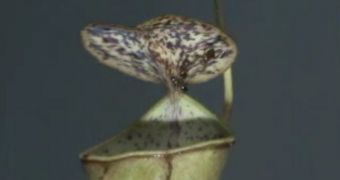A group of scientists from the University of Cambridge have discovered a trick employed by the pitcher plant Nepenthes gracilis for capturing insects. It only works when it's raining, and it involves the plant using its lid as a large springboard.
Usually, when it's pouring outside, insects seek refuge under leaves, in order to prevent getting wet. Hiding under the lid of this particular pitcher plant is not the smartest idea in the world for ants and other bugs.
Whenever a drop of water hits the lid from above, it vibrates strongly, causing any insect attached to its underside to lose its footing, and plunge directly into the digestive liquid underneath. Short of divine intervention, nothing can then save the insects from their fate.
Details of how the plants do this appear in a paper published in the latest issue of the peer-reviewed open-access scientific journal PLoS ONE, which is edited by the Public Library of Science.
Plants of this family usually have pitcher-shaped leaves and non-adherent, highly slippery surfaces on their upper rims and inner walls. Any insect unfortunate enough to venture inside can no longer find its way out, and eventually becomes exhausted from trying to escape. Its fate is then sealed.
It is also important to note that the pitcher rim is usually covered in a very thin film of water that does not allow the adhesive pads on the feet of insects to make contact with the actual surface of the leaf. Researchers say that insects then simply glide into the digestive liquid.
The effect is similar to aquaplaning, which is what happens to cars when they try to travel too fast on the surface of very wet roads. But apparently Nepenthes gracilis does not satisfy its hunger exclusively via this standard mechanism.
“It all started with the observation of a beetle seeking shelter under a N. gracilis lid during a tropical rainstorm. Instead of finding a safe – and dry – place to rest, the beetle ended up in the pitcher fluid, captured by the plant,” Dr. Ulrike Bauer explains.
“We had observed ants crawling under the lid without difficulty many times before, so we assumed that the rain played a role, maybe causing the lid to vibrate and ‘catapulting’ the beetle into the trap, similar to the springboard at a swimming pool,” he adds.
Bauer, who holds an appointment with the University of Cambridge Department of Planet Sciences, was also the lead author of the PLoS ONE paper.

 14 DAY TRIAL //
14 DAY TRIAL //